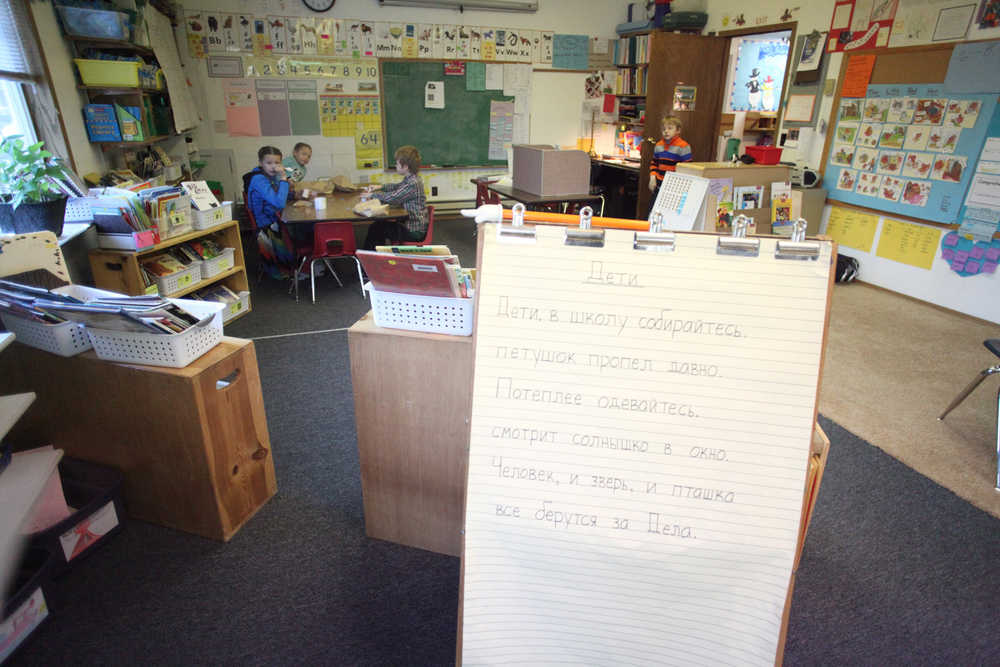Kenai Peninsula Borough voters may be asked this fall to take on several million dollars in bond debt to pay for a new school in the remote Russian Old Believer community of Kachemak-Selo.
The approximately 50 students at the K-12 school in Kachemak-Selo, operated by the Kenai Peninsula Borough School District, use three older buildings — one is converted home — that have long needed repair or replacement. Students and parents have reported cracked walls, drafts, plumbing and roof leaks and inadequate equipment.
Borough Mayor Charlie Pierce has proposed an ordinance that would ask voters this fall whether the borough can issue bonds to cover the required local match for state grant funds for the school. The proposed ordinance lists the total bond amount as $3.5 million, but during the Kenai Peninsula Borough Assembly’s finance committee meeting May 15, Pierce said the administration plans to amend that to about $5.39 million to access the full state grant of approximately $10.87 million. The ordinance will be on the agenda at the assembly’s June 5 meeting.
Kachemak-Selo, the farthest east of three Russian Old Believer villages east of Homer, is at the bottom of a large hill without a safe road to drive from the village to the road system. Because of that obstacle, the state deems Kachemak-Selo as its own attendance area and requires the school district to provide a school for the students there.
“Local residents access the village via an established trail; however, there is not an accessible road as defined by borough or state road standards,” wrote Borough Finance Director Brandi Harbaugh in a memo to the assembly. “Since 2012, borough and school district personnel evaluated alternate transportation methods in lieu of school construction.” Officials determined building a road is not feasible “due to the geographical inaccessibility.”
Kenai Peninsula Borough School District Assistant Superintendent Dave Jones said during the assembly finance committee meeting that the district’s board of education has not yet committed formal support to the school construction, but the board will likely discuss it in the future.
“There are a number of students there that currently are being educated in sub-par buildings,” he said. “For those kids, educationally, I think it’s a good thing.”
There are about 50 students in the school, though the enrollment was about 70 when the idea of a new school building was originally drafted, he said. If the new school is built, the enrollment may increase again, Jones said. “It’s believed now that because of the way the school is built, people are making other educational arrangements.”
The current plan calls for a new 18,599-square-foot K-12 school, according to the Kenai Peninsula Borough’s purchasing and contracting department website, which handles capital projects for the borough.
The school district and borough began working on the project in 2012, originally targeting improved road access so that students could reach Homer. Later, the idea of a single school to serve Kachemak-Selo and the neighboring villages of Voznesenka and Razdolna was pitched, but later scrapped because the road project was deemed impossible. The borough asked for funding from the state to build Kachemak-Selo its own school in 2013. The state legislature in 2016 approved the state grant with a required local match.
Several Kachemak-Selo community members voiced support for the bonds at the assembly’s May 15 meeting. Tim Whip, principal at the Razdolna and Kachemak-Selo schools, thanked the mayor for the bond package in his testimony to the assembly.
“The school is deteriorated to the point where it is an unsafe condition for students,” Whip said. “Something has to happen.”
If the assembly approves the ordinance, voters will decide whether to approve the bonds in the Oct. 2 election. Borough property tax revenues would be used to repay the bonds.
Reach Elizabeth Earl at eearl@peninsulaclarion.com.

